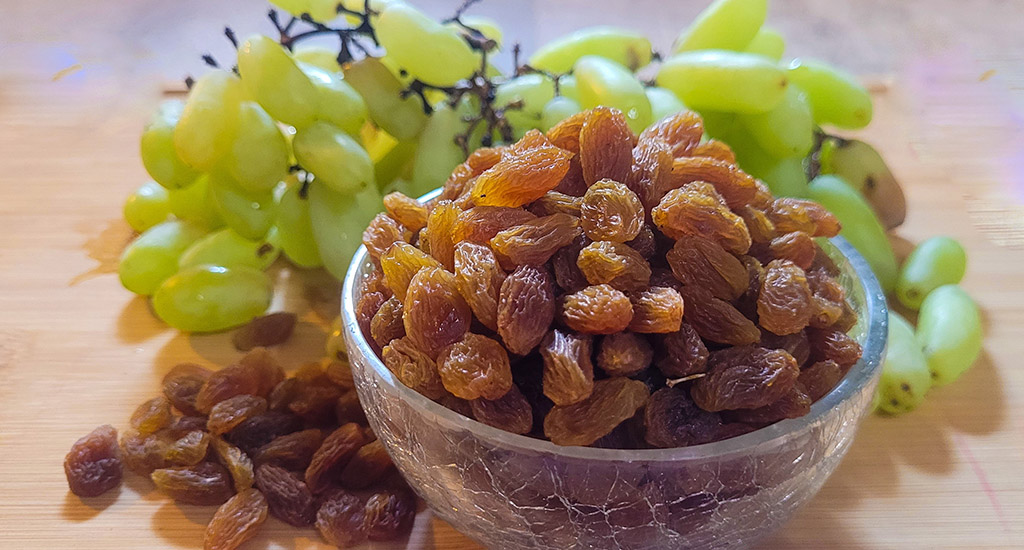What’s common between fruit-and-nut chocolate, Jamaican rum cake and halwa? Yes, it’s the delectable raisin. This sun-dried, sweet, chewy dried fruit in your kitchen may have just come from the vineyards of the hot and arid plains of Sangli district in Maharashtra.
Villages in seven taluks – Tasgaon, Miraj, Palus, Kadegaon, Atpadi, Kavathe-Mahankal and Jath – of Sangli have emerged as the hub of raisins. And these sweet little things are not made from any random grapes. Raisin producers of Sangli prefer grape varieties such as Manikchaman and Tas-a-Ganesh. Villages here account for 80 percent of the raisins produced in the country. And come to think of it, grapes were not even grown here earlier.
The raisin belt
Drive the 35 km stretch from Nagaj to Junoni on the Sangli-Solapur highway – also known as bedana (Marathi for raisins) belt – any time between late January and March, and you’re likely to come across grapes being dried either in open fields or stacked on wire meshes spread under shade nets.

Production of raisins began around five decades ago in Tasgaon taluk, which is endowed with suitable climatic conditions for growing grapes.
Known for their tempting and fragile appearance and distinct taste, raisins produced in Sangli received the Geographical Indication tag in 2016.
Also Read | A juicy outcome for Maharashtra mango farmers
Where sweetness matters
Berries such as the Thompson Seedless, Sonaka, Tas-a-Ganesh and Manikchaman varieties, which are elongated and have a Brix (sugar content) level of 18-20 are best suited for making raisins as they dry faster.
An individual berry variety is distinguished for its specific aroma, colour, taste, shape, size, pulpiness and softness. The higher the number of bunches on the vine, the lower the sugar content of the grapes.
Anushka and Super Sonaka are also grown here as table grapes to be consumed while fresh.
Consistently irrigated and grown between October and January, the vines are heavy with fruit by February. That’s when the tip of the grapes undergo a change in colour and attain a sweet flavour, indicating that the berries are ready to be harvested and dried.
From grapes to raisins
The grapes are dried under shade nets. The lack of walls allows hot winds to blow across during the day. At night the sides of the sheds are curtained to prevent cool air from entering the enclosures.

“During the drying process we pray that there shouldn’t be cloudy days or light rains, as they can lead to blackening of raisins or affect the overall quality,” said Parmanand Gavane, who produces 75 tonnes of raisins annually from grapes grown on three acres in Belanki village of Miraj taluk.
Also Read | Money blooms in India’s ‘flower village’ of Nikamwadi in Maharashtra
From picking to drying, the process is laborious and handled by migrant workers who come from Madhya Pradesh and Bihar. Workers manually reposition the bunches every day to ensure uniform drying. The drying process also includes two stints of wash and an oil solution spray.
After 12-14 days the grape bunches turn into raisins – 1kg of succulent berries transformed into 250g of chewy dried fruit. The crinkly texture achieved, the stalks are mechanically removed and then sorted according to colour and size, and sent to cold storage units.
The cold storage units charge Rs 500 a month for storing a tonne of raisins. They are concentrated in Sangli and Solapur, which have emerged as the state’s ‘raisin districts’.
Growing grapes in a rain shadow region
This region has become the grape hub only in the recent past, with farmers moving on from growing water-intensive crops such as sugarcane, turmeric and betel leaf. These are acutely water-stressed areas with annual rainfall mostly ranging between about 350 mm and 650 mm.

Being a rain shadow region, Sangli and its surrounding areas face frequent drought conditions. This has made the farmers install drip irrigation systems in their vineyards that are spread in land patches measuring 2 acres to 25 acres.
Vithal Chavan of Umadi village in Jath taluk harvests 45 tonnes of grapes from his 9-acre farm.
“Between 2016 and 2018, Jath suffered the worst drought and I had to ferry water in tankers from Bhivargi, 35 km away. At that time, I spent nearly Rs 1 crore to keep my vineyards alive,” said Chavan. “Now I bring water from 8 km away and store it in ponds on my farm.”
ALSO READ: A thousand ponds for this Maharashtrian village’s vineyards
India’s raisin market
The vineyards in Sangli are currently spread over 60,000 acres and involve around 10,000 families.
“We differ from other countries when it comes to the consumption of grapes. Of the total production of grapes, only 27 percent of the fruit is used for making raisins,” said Chandrakant Landge, chairman, Central Research Committee of Maharashtra State Grape Growers Association (MSGGA) and owner of a 13-acre vineyard in Manerajuri village.
“About 71 percent of the produce is used as fresh fruit. A very small amount — about 1.5 percent – is used for alcohol production while 0.5 percent goes into making juice,” he added.

The 33,000-member MSGGA provides technical backup through R&D and extension services, in addition to importing and distributing necessary viticulture inputs.
Export potential of Sangli’s raisins
Raisins are auctioned by the Agricultural Produce & Livestock Market Committees (APMC) located in Sangli, Solapur and Pandharpur.
The price of quality graded raisins, which are known as a ‘luxury’ product, ranges between Rs 160 and 250 per kg.
“You’ll be surprised to know that the ‘luxury’ grade doesn’t have an export market for it prefers the low-quality ones,” said Landge.
Though India ranks fifth in raisin production, it ranks 10th in its export – competing mainly with Turkey, the United States, Iran and China – as it exports only 3 percent of raisins produced in the country.
Also Read | Strawberry sweetens deal for Maharashtra farmers
“The difference between the domestic market price and the export price is negligible. That’s why raisin producers do not seek out exporters,” said Sanjay Borgale, whose family grows grapes in 30 acres specifically for raisins, while in another 15 acres it grows residue-free grapes for domestic and export markets.
Experts believe that the recent opening of a market in Vashi – the country’s biggest market for wholesale agricultural produce – is likely to push up sales and usher volumes in exports.
The lead image shows a bowl of Sangli’s raisins, beside a bunch of grapes that are used to make the raisins (Photo by Hiren Kumar Bose)
Hiren Kumar Bose is a journalist based in Thane, Maharashtra. He doubles as a weekend farmer.








